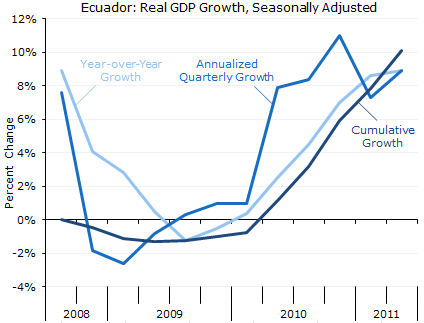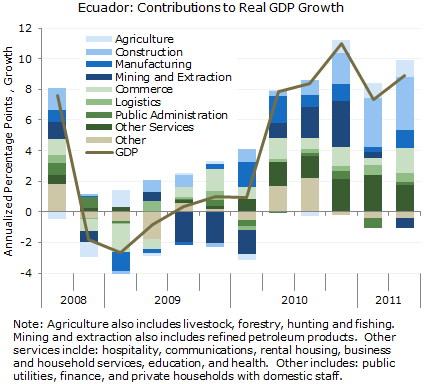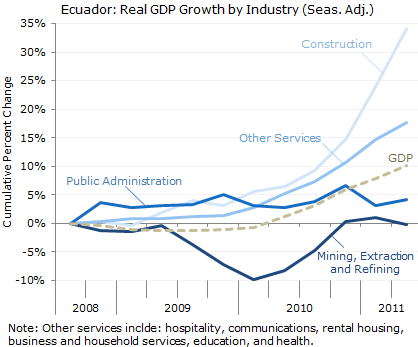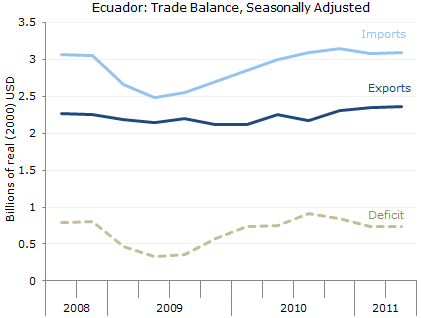Fact-based, data-driven research and analysis to advance democratic debate on vital issues shaping people’s lives.
Center for Economic and Policy Research
1611 Connecticut Ave. NW
Suite 400
Washington, DC 20009
Tel: 202-293-5380
Fax: 202-588-1356
https://cepr.net
October 7, 2011 (Latin America Data Byte)
By Rebecca Ray
The petroleum sector shrank at a 4.7 percent annual rate, as production subsided from unusually high first-quarter levels.
Ecuador’s GDP grew at an 8.9 percent annual rate in the second quarter, up from a 7.3 percent rate in the first quarter. This is Ecuador’s second-fastest quarterly growth rate since the recession, surpassed only by the fourth quarter of 2010. GDP has also grown 8.9 percent compared to the second quarter of 2010, when it first rose above its pre-recession peak.

GDP by Sector
GDP growth was led by construction, commerce, and other services (which includes hospitality, communications, rent, business and household services, education and health). Together, these three sectors accounted for 6.9 percentage points of annualized growth, over three quarters of the economy’s total expansion. Construction in particular has contributed strongly to overall GDP growth for the last six quarters, with this contribution increasing each quarter over the last four.

The strong contribution of construction, other services, and commerce is notable given that these three sectors account for less than half of the economy’s total size. However, they have surged enough recently to have a sizeable impact on overall growth. As the figure below shows, construction and other services are the only sectors to outpace overall GDP growth since the recession. Moreover, construction has soared 25.9 percent since the second quarter of 2010 and accelerated to a 36.8 percent annual rate in the second quarter of 2011, as the government moved to extend financing. “Other services” have also grown at double-digit rates, expanding 11.9 percent over the last four quarters, although they slowed slightly to a 10.9 percent annual rate in the second quarter of 2011. Meanwhile, commerce grew at an 11.4 percent annual rate in the second quarter, although it has not fared as well as the overall economy over the last year (with 6.8 percent growth year-over-year).

The petroleum sector (included in mining, extraction and refining in the figure above) shrank for the first time in more than a year, at a 4.7 percent annual rate, and fell below their pre-recession level. The decline is not surprising given that in the first quarter, Ecuador produced an average of 504 thousand barrels per day, 16 percent more above permitted by its OPEC quota – and a higher production level than at any time since early 2008, when quotas were higher than they currently are. The decline to 499 thousand per day in the second quarter was an appropriate adjustment. Mining and extraction grew, but at a modest 1.1 percent annual rate, while refining contracted sharply, shrinking at a 34.1 percent annual rate. Nevertheless, due to strong growth in the second half of 2010, the petroleum sector has still grown 8.9 percent year-over-year.
GDP by Expense Category
Among domestic sources of demand, GDP growth was driven by private consumption and gross fixed capital formation (GFKF). GFKF had its sixth straight quarter of double-digit expansion, growing at a 16.7 percent annual rate in the second quarter and 17.2 percent year-over-year. It contributed 5.0 percentage points to overall annualized GDP growth. Private consumption has grown at 6.9 percent over the last year, and accelerated to a 9.4 percent annual rate in the second quarter and contributed 6.4 percentage points to quarterly GDP growth. The only domestic expense category to negatively affect overall GDP growth was inventories, which shrank for a third consecutive quarter and shaved 2.9 percentage points off of annualized quarterly growth.

In the external sector, both imports and exports rose in the second quarter at approximately the same pace (2.0 compared to 1.7 percent annual growth rates) for a slightly improved – though essentially flat – trade balance. This reverses the first quarter’s anomalous decline in imports, the first such decline outside of a recession. However, it is not yet possible to say if the current account also improved, as remittances – an important factor – have not yet been reported for the second quarter.

Overall, the economy continues to be carried by construction, services, and investment. It will bear watching in future quarters whether construction continues to soar, and if the petroleum sector can return to growth.